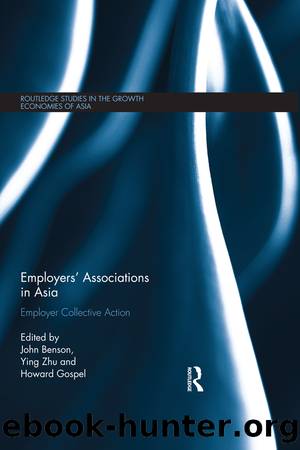Employers' Associations in Asia by John Beson Ying Zhu Howard Gospel

Author:John Beson, Ying Zhu, Howard Gospel [John Beson, Ying Zhu, Howard Gospel]
Language: eng
Format: epub
Tags: Nonfiction, Social & Cultural Studies, Social Science, Cultural Studies, Ethnic Studies
ISBN: 9781317372844
Publisher: Taylor and Francis
Published: 2017-06-26T04:00:00+00:00
7
Employersâ associations in China
Promoting interaction among the key stakeholders
Qijun Jiang and Ying Zhu
Introduction
The peak body of employersâ associations in China, namely the China Enterprise Confederation/China Enterprise Directors Association (CEC/CEDA), was established in 1979 as part of the national government policy of âeconomic reformâ and âopen door to outside worldâ (CEC/CEDA 2015). The major function of this body, based on its leadersâ statements, is to promote interaction between the government and enterprises (Wang 2015). This function appears to differ substantially from the function found in other economies such as Singapore, where the major function is tripartite engagement (see Chapter 5, this volume). Such a unique approach towards the role and function of employersâ associations reflects a particular reality of industrial relations (IR) systems in China, namely that the government is very strong and trade unions may be seen as a branch of the government body. Given this context, engagement with trade unions is less important and tripartite engagement need not be specifically mentioned in mission statements.
We begin with a description of the reality in Chinaâs overall IR context, in particular the role of employersâ associations. Thus far, there have been many publications on the role and functions of trade unions in China (Hui and Chan 2014; Pringle 2011; Taylor, Chang and Li 2003; Zhu et al. 2011), but limited research and publications in Chinese and English literature have been available on the role and function of employersâ associations in China.
This chapter aims to tackle a key question: What are the major roles and functions of employersâ associations in China under the economic reform process? The remainder of the chapter provides an overview of the national context within which employersâ associations are engaged with government, help member enterprises, and are involved in policy and legislation on labour laws, industrial planning and workforce development. The overview of the national context offers an understanding of the structure and strategies of the associationsâ peak body. To complement the analysis and before drawing conclusions, the chapter assesses the scope and level of influence the employersâ associations have on employment, economic and industrial development, and IR systems in China.
Download
This site does not store any files on its server. We only index and link to content provided by other sites. Please contact the content providers to delete copyright contents if any and email us, we'll remove relevant links or contents immediately.
International Integration of the Brazilian Economy by Elias C. Grivoyannis(91728)
The Radium Girls by Kate Moore(11930)
Turbulence by E. J. Noyes(7942)
Nudge - Improving Decisions about Health, Wealth, and Happiness by Thaler Sunstein(7622)
The Black Swan by Nassim Nicholas Taleb(7016)
Rich Dad Poor Dad by Robert T. Kiyosaki(6413)
Pioneering Portfolio Management by David F. Swensen(6229)
Man-made Catastrophes and Risk Information Concealment by Dmitry Chernov & Didier Sornette(5925)
Zero to One by Peter Thiel(5691)
Secrecy World by Jake Bernstein(4652)
Millionaire: The Philanderer, Gambler, and Duelist Who Invented Modern Finance by Janet Gleeson(4386)
The Age of Surveillance Capitalism by Shoshana Zuboff(4216)
Skin in the Game by Nassim Nicholas Taleb(4165)
Bullshit Jobs by David Graeber(4101)
The Money Culture by Michael Lewis(4083)
Skin in the Game: Hidden Asymmetries in Daily Life by Nassim Nicholas Taleb(3935)
The Dhandho Investor by Mohnish Pabrai(3705)
The Wisdom of Finance by Mihir Desai(3658)
Blockchain Basics by Daniel Drescher(3511)
